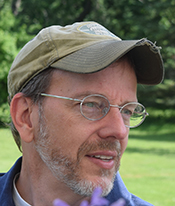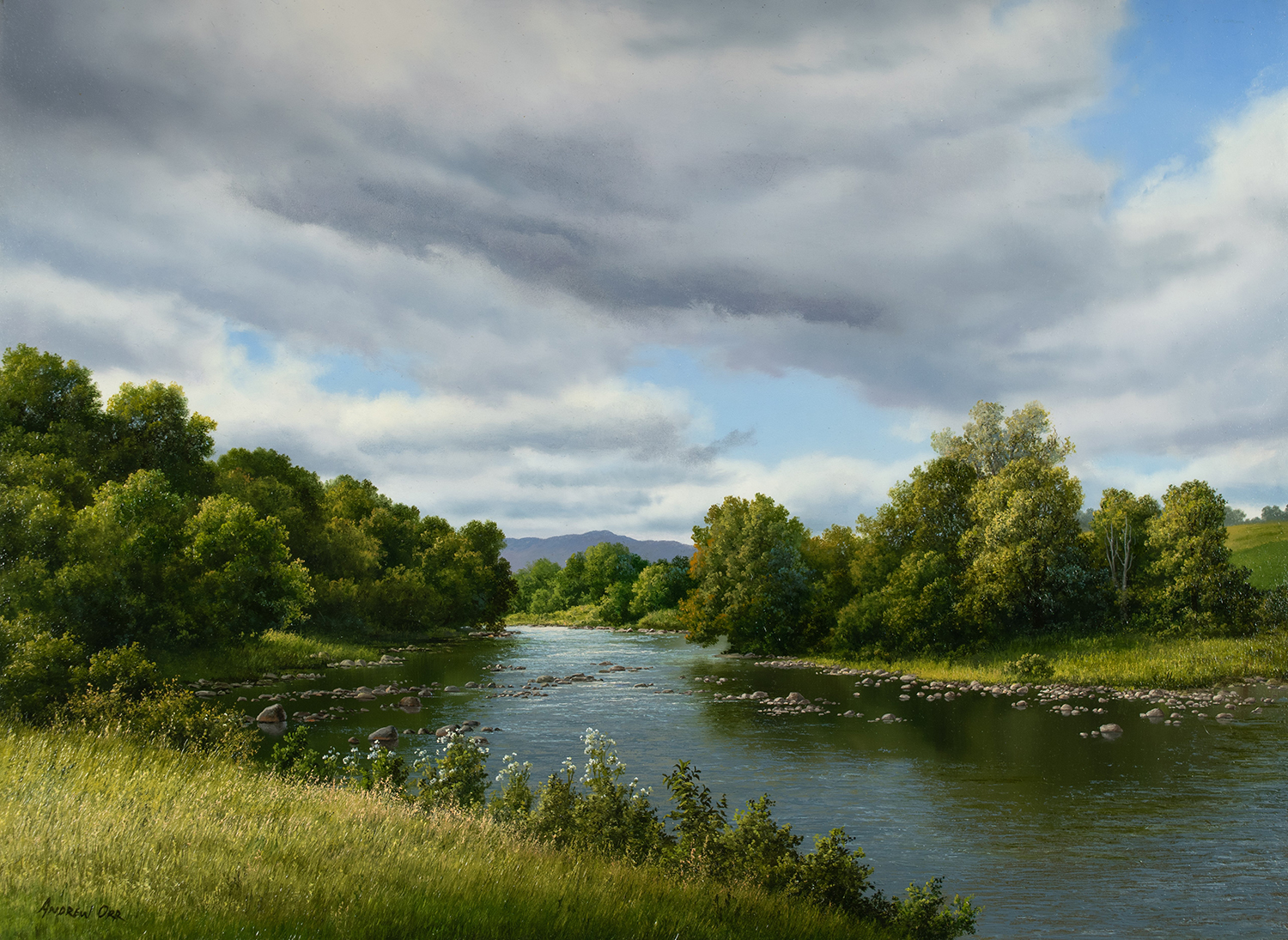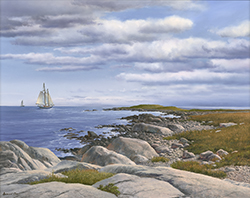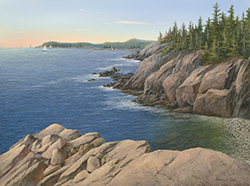Andrew Orr
(Born 1969)
After a Later Summer Rainfall
Oil on panel
12 x 16 inches
Signed
BIOGRAPHY - Andrew Orr (Born 1969)

Born in the high desert city of Albuquerque, New Mexico in 1969, Andrew Orr and his older sister grew up in an artistic family. Three generations of women in his mother’s family enjoyed the work of over-glaze painting on porcelain. [i] His father inherited a love of music from his own parents, enjoying singing and playing piano as well as playing the clarinet in his high school band. Not surprisingly, Orr’s parents had friends who were artistic as well. He recalls one family friend in particular who was a landscape painter; she visited often, and more importantly she exemplified the possibility of having a career in the visual arts.
Orr’s art education began in high school where he took courses in drawing, painting, and photography. In addition, he was always interested in music and it was that passion that led him to major in music at Oklahoma Christian University, a small liberal arts college in Oklahoma City. It was there that Orr first had an opportunity to travel extensively; each semester took him to new places in Mexico or Europe. He graduated in 1991 with a BA in Music and left the US in 1992 to teach English as a second language in the Czech Republic. In recalling those years, he notes that his travels “informed much of my thinking about how I view cultural differences today”
It was his voice teacher in Vienna during the early 1990s who helped Orr to consider his career direction more seriously by asking if singing was what he wanted to do. Somewhat unexpectedly, he realized that it was not. After a year of teaching in the Czech Republic, he returned to Albuquerque in 1993. Over the next several years, he attended the University of New Mexico sporadically. There, he took several drawing courses as well as a pottery class. Although he learned that he was “not a potter”, the course did provide an “opportunity to play in the mud”, and to allow him to grieve the recent death of his mother “sitting around the kilns at night near the banks of the Rio Grande River.”
During these years in Albuquerque Orr “paid [his] dues by working for a bank for five years”. And he started painting again. When a co-worker asked to see his artwork—and then asked to buy some—Orr’s transition to becoming a full-time artist was underway. His colleague suggested that he explore a local gallery and he was soon exhibiting small still-life paintings. Before long, he was showing his work at art fairs and several galleries.
By the time he was twenty-six, Orr had shifted to part-time employment at the bank while also working as a studio assistant to the sculptor Bill Girard, who became his mentor. Girard offered aesthetic critiques as well as some valuable advice, encouraging Orr to develop a career plan based on finding jobs where he could work “with a brush in hand.” Over the next decade, that plan would include a variety of projects involving painting, watercolors, graphic design projects, and porcelain painting.
Having learned porcelain painting from his mother and grandmother, Orr recognized that he not only had well-honed skills in a specialized field, but that he was one of a very small number of practitioners in the US. For fifteen years, he traveled throughout the US as well as Australia, New Zealand, and the UK teaching porcelain painting to students whose life experience provided yet more learning opportunities. “I often wondered who was teaching whom. I learned so much from the years of the wisdom of life accumulated by these eager porcelain painting students.” Looking back on those days now, Orr says that he felt “really lucky. Teaching was a means of giving back.”
In 2003 he decided to move to Vermont. He had fallen in love with the landscape as a teenager when his family made a trip to visit relatives there. “I liked the quiet” he says as he recalls how much he admired the life that his aunt and uncle had created on the shores of Lake Champlain. As a painter, he also notes that “I appreciate the intimacy of the landscape in Vermont.” His first stop was the historic village of Poultney on the state’s western border with New York. First settled by Europeans in the 1770s, Poultney’s historical context was dramatically different from that of Albuquerque, as was the forested and hilly topography of the Poultney River valley where Orr found abundant subjects for his painting.
He subsequently moved to the hamlet of Waterville, having curtailed his traveling and teaching schedule in order to devote his attention more fully to painting. The north branch of the meandering Lamoille River provided a compelling subject as he explored the possibilities of landscape painting with increasing intensity.
By 2009 Orr began to seek additional opportunities to study the natural world and expand his skills as a painter. To that end, he enrolled in a workshop with David Curtis, (1950-2021), a plein air painter and experienced teacher based in Gloucester, Massachusetts. For the next two years he concentrated on learning the nuances of plein air painting, and over time, developed a close relationship with Curtis. In fact, it was Curtis who submitted Orr’s name for membership in the Guild of Boston Artists where he continues to exhibit today. [ii]
In 2011, Orr also began to study with Joseph McGurl (b. 1958), who integrates the techniques of 19th century Luminism into his paintings. This approach “opened a door” for Orr, encouraging him to take his time with his painting and “find the tool that lets me say what I want to say”. McGurl’s reverence for nature and his handling of composition and light was exactly what Orr was seeking; as he remembers “I was receptive to the message at the right time.”
Professional recognition came with increasing frequency as Orr expanded his range of exhibitions and juried competitions. Although his work received positive reviews and awards beginning the 1990s, he is particularly proud of more recent honors from his fellow-artists. One of his paintings won first place in the Vermont Plein Air Competition sponsored by Plein Air Magazine; the judge was M. Stephen Doherty, then the editor of the publication. Orr notes that recognition from an artist such as Doherty, whose plein air work is widely respected, was especially meaningful.
Three years later, Orr’s work was featured in an exhibition at the Bryan Gallery in Jeffersonville, Vermont entitled Generations: Teachers / Artists / Students. The show was organized around the concept of artistic legacies transmitted from one generation to the next. An accompanying article in the American Art Review opened with one of Orr’s paintings and a discussion of the aesthetic heritage passed from R. H. Ives Gammell (1893-1981) to David Curtis to Orr. [iv] The following year, in 2016, the Bryan Gallery hosted Andrew Orr and His Students, an exhibition of Orr’s work and that of his students. This show ran concurrently with Robert Douglas Hunter and His Students; Hunter was then considered the “dean” of the Boston School of painting, which made the shared venue especially memorable for Orr.
In 2021, Orr received the Charles Movalli Award of Excellence in Painting from the Guild of Boston Artists. This is the highest honor that the Guild bestows, and it is particularly significant because the recipient is selected by his fellow Guild members during the annual members exhibition.
Orr’s personal life continued to evolve as he immersed himself in the traditions of landscape painting and teaching. In 2017 he moved to northern Vermont, having purchased twelve acres near the village of Richford on the Canadian border. The former owner of the property, who also happened to be an artist, planted extensive gardens, some berry bushes and apple trees. A converted and renovated horse barn was waiting to become his studio.
The surrounding hills offer an expansive view of the landscape while the countryside of the Missisquoi River valley presents gentler prospects of fields and forests—all of them the subjects of Orr’s painting. During the COVID-19 pandemic, he found solace in all of those landscapes. “I was very isolated, but it gave me the time to dive into the craft of painting more deeply. There’s a quietness in some of the paintings from that time. I tried to let the quiet come in—and to let the landscape heal me.”
Looking forward, Orr plans to continue painting the Vermont landscapes and teaching two workshops each year, but he is also pleased to be able to explore new locations again. So far, his travels have led him to Maine, Nova Scotia, Wales, and England, with sketchbook in hand to record the variety of scenes each place reveals. Those drawings often become the subject of future paintings. On the immediate horizon, he is planning to spend more time in the Midwest, a region that he has not yet explored in any depth. He anticipates new joys along the way, along with plenty of fresh landscapes to capture on canvas.
Janet Whitmore, Ph.D.
Membership:
Elected Artist Member, Guild of Boston Artists
Current Board of Managers member, Guild of Boston Artists
Notes
[i] Over-glazing is a technique that can be used on a variety of ceramics, but it is most often associated with porcelain. The over-glazing is applied to porcelain that has already been fired once. When the over-glazing is completed, the piece is fired again at a lower temperature, which allows the designer to incorporate brighter and more intense hues that would not survive the high temperatures of the initial firing. For examples of this technique, please see the Victoria and Albert Museum website at: https://collections.vam.ac.uk/search/?page=1&page_size=15&id_material=AAT10662&id_technique=AAT53914
[ii] The Guild of Boston Artists is a cooperative gallery established in 1914 by a group of artists seeking to “promote representational painting and sculpture of enduring beauty by leading New England artists.” Among others, the founding members included Frank Benson, William Paxton, Lila Cabot Perry, and Edmund Tarbell. Historically, the Guild has served as an important community resource for exhibitions and educational programs, classes, and workshops. For more information, please see the Guild’s website at: https://www.guildofbostonartists.org and the Smithsonian Archives of American Art, Guild of Boston Artists records, 1914-1978 at https://www.aaa.si.edu/collections/guild-boston-artists-records-7278
[iii] Luminism is a 20th century art historical term used to describe the mid-19th-century school of American painting that focused on the effects of light in the landscape. It emphasized a sense of tranquility and luminous lighting, typically viewed from a distance. Unlike their European colleagues, the Luminist painters sought to eliminate all evidence of their brushstrokes. Painters associated with this movement include Sanford Gifford, Martin Johnson Heade, Fitz Hugh Lane and John Kensett. There is some overlap with the painters of the Hudson River School as well. For more information, please see John Wilmerding’s seminal book on the subject, American Light: the Luminist Movement 1850–1875 (Princeton, NJ: Princeton University Press, 1989) and Andrew Wilton and Tim Barringer, American Sublime: Landscape Painting in the United States, 1820–1880 (Princeton, NJ: Princeton University Press, 2002).
[iv] Mickey Myers, “Generations: Teachers / Artists / Students” American Art Review Vol. XXVII, No. 4, 2015:104-109.
| AVAILABLE WORKS | |||



